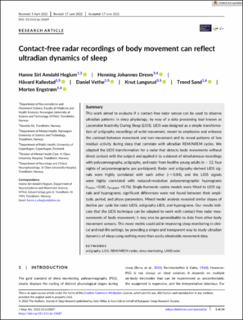| dc.contributor.author | Heglum, Hanne Siri Amdahl | |
| dc.contributor.author | Drews, Henning Johannes | |
| dc.contributor.author | Kallestad, Håvard | |
| dc.contributor.author | Vethe, Daniel | |
| dc.contributor.author | Langsrud, Knut | |
| dc.contributor.author | Sand, Trond | |
| dc.contributor.author | Engstrøm, Morten | |
| dc.date.accessioned | 2023-04-12T09:23:18Z | |
| dc.date.available | 2023-04-12T09:23:18Z | |
| dc.date.created | 2022-09-27T17:47:48Z | |
| dc.date.issued | 2022 | |
| dc.identifier.citation | Journal of Sleep Research. 2022, 1-14. | en_US |
| dc.identifier.issn | 0962-1105 | |
| dc.identifier.uri | https://hdl.handle.net/11250/3062572 | |
| dc.description.abstract | This work aimed to evaluate if a contact-free radar sensor can be used to observe ultradian patterns in sleep physiology, by way of a data processing tool known as Locomotor Inactivity During Sleep (LIDS). LIDS was designed as a simple transformation of actigraphy recordings of wrist movement, meant to emphasise and enhance the contrast between movement and non-movement and to reveal patterns of low residual activity during sleep that correlate with ultradian REM/NREM cycles. We adapted the LIDS transformation for a radar that detects body movements without direct contact with the subject and applied it to a dataset of simultaneous recordings with polysomnography, actigraphy, and radar from healthy young adults (n = 12, four nights of polysomnography per participant). Radar and actigraphy-derived LIDS signals were highly correlated with each other (r > 0.84), and the LIDS signals were highly correlated with reduced-resolution polysomnographic hypnograms (rradars >0.80, ractigraph >0.76). Single-harmonic cosine models were fitted to LIDS signals and hypnograms; significant differences were not found between their amplitude, period, and phase parameters. Mixed model analysis revealed similar slopes of decline per cycle for radar-LIDS, actigraphy-LIDS, and hypnograms. Our results indicate that the LIDS technique can be adapted to work with contact-free radar measurements of body movement; it may also be generalisable to data from other body movement sensors. This novel metric could aid in improving sleep monitoring in clinical and real-life settings, by providing a simple and transparent way to study ultradian dynamics of sleep using nothing more than easily obtainable movement data. | en_US |
| dc.language.iso | eng | en_US |
| dc.publisher | Wiley | en_US |
| dc.rights | Navngivelse 4.0 Internasjonal | * |
| dc.rights.uri | http://creativecommons.org/licenses/by/4.0/deed.no | * |
| dc.title | Contact-free radar recordings of body movement can reflect ultradian dynamics of sleep | en_US |
| dc.title.alternative | Contact-free radar recordings of body movement can reflect ultradian dynamics of sleep | en_US |
| dc.type | Peer reviewed | en_US |
| dc.type | Journal article | en_US |
| dc.description.version | publishedVersion | en_US |
| dc.source.pagenumber | 1-14 | en_US |
| dc.source.journal | Journal of Sleep Research | en_US |
| dc.identifier.doi | 10.1111/jsr.13687 | |
| dc.identifier.cristin | 2056077 | |
| cristin.ispublished | true | |
| cristin.fulltext | original | |
| cristin.qualitycode | 1 | |

